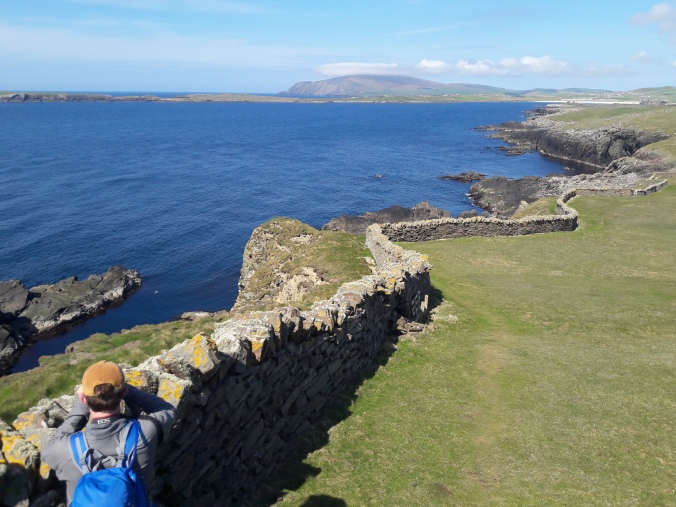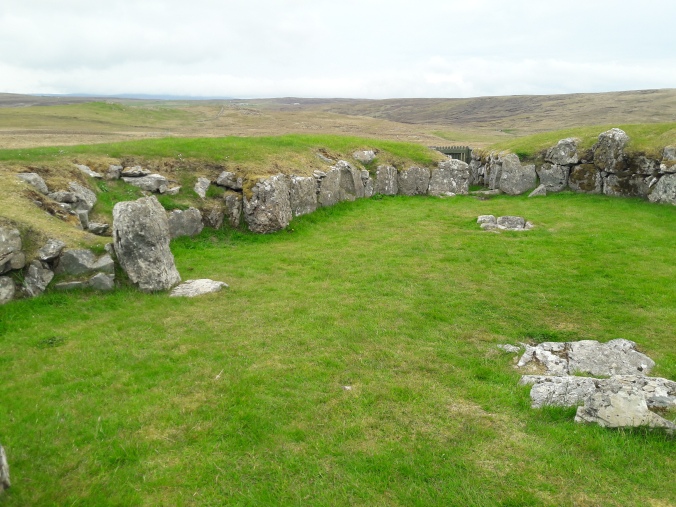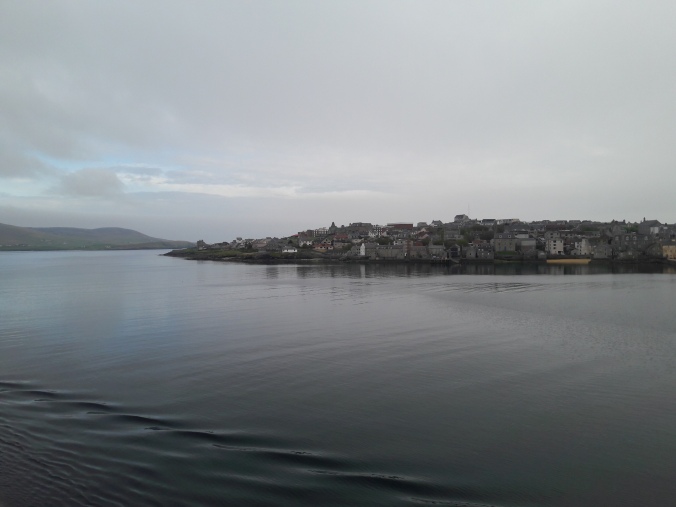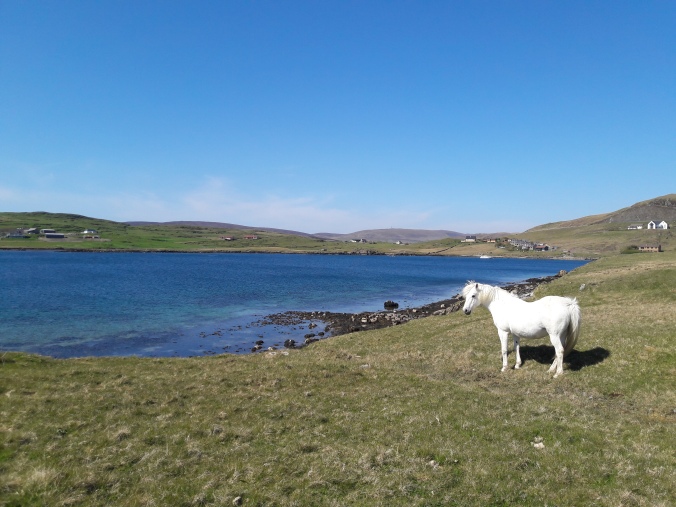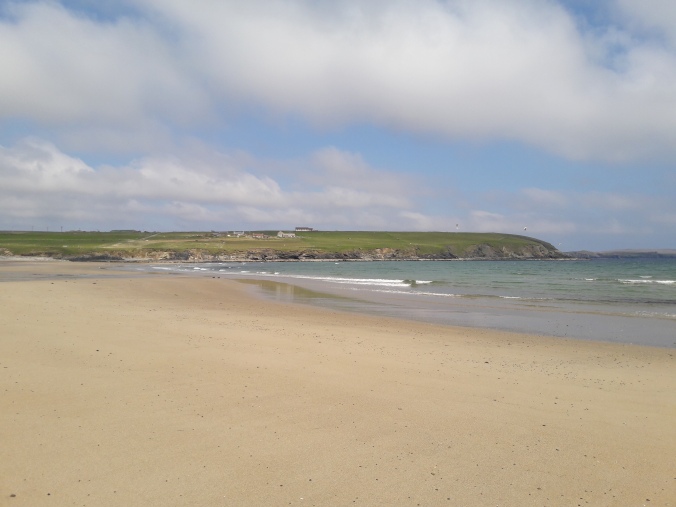
Geology
Shetland is a geologist’s dream, with a fascinating array of rare and unusual rock formations scattered across the various islands. This is down to Shetland’s surprisingly chaotic geological history.

Shetland began its life, like the rest of Scotland, as part of the North American landmass, with England and the rest of Europe far away in their own continent. The oldest rocks in Shetland, 3 million year old gneiss, stem from this time. As the oceanic plates slowly drove the two continents into a head on collision the two landmasses collided, forcing up ocean sediments as well as some of the ocean plate itself. Today Unst and Fetlar are still made up of, in part, the old American continent and the oceanic crust which rose up to meet it. As the oceanic crust is rarely exposed to the surface this is one of the best places in the world to come into contact with the wonderfully green serpentines and olivines make up much of the crust.
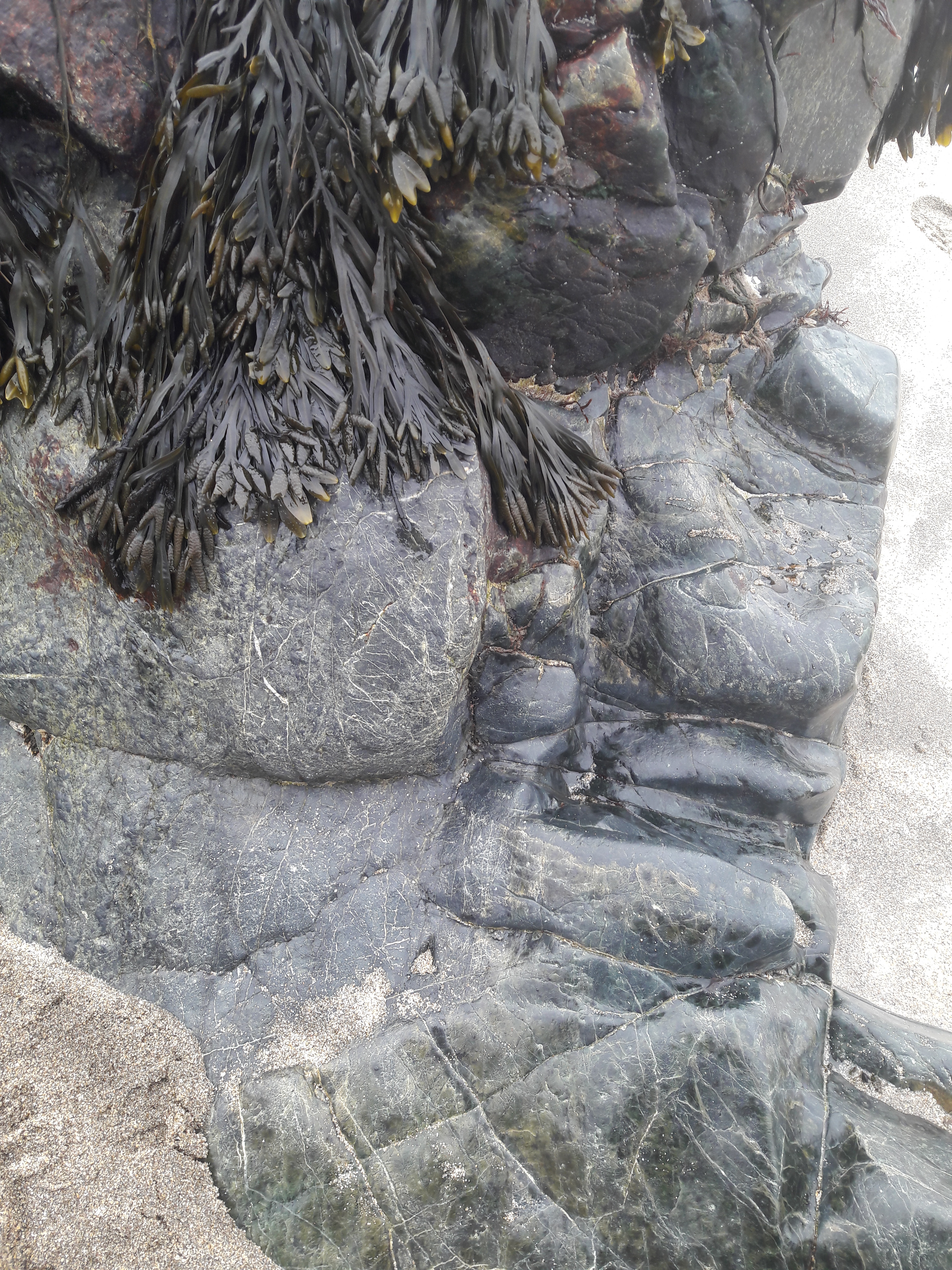
The collision of these two continents caused the creation of the Caledonian mountains, once as high as the Himalayas are today. Pangaea, the supercontinent formed during this period, was a vast desert, however the high peaks of the Caledonian range attracted the rain clouds, and streams, rivers and lakes formed. Some of these lakes stayed long enough to allow species to live within them and today fossils of these creatures can be found in the stones at the south and west of the mainland, forever preserved amongst ancient mud and sandstones.
Perhaps most excitingly of all is the presence of one of the world’s best preserved volcanic cross sections in Northmavine. Here you can view the flanks of a long extinct volcano, which erupted as magma was forced to the surface during the creation of the Pangaea.
Over 300 millions years Shetland had moved from the south pole, where it was part of the American continent, to the equator. Finally, 300 million years ago a new rift formed, the start of the North Sea, pushing Shetland towards its current position. Another rift then formed some 60million years ago, becoming the Atlantic Ocean, leaving Shetland adrift in a sea of blue.
History
The first archaeological evidence of people on Shetland stems from the Neolithic era, around 3,000 years ago. These subsistence farmers lived in small settlements working the land with oxen, leaving behind tantalising traces of their existence. Although Shetland had been drastically altered by human occupation much of what is below the soil had been remarkably untouched. This means today you can visit the Scord of Brouster and wander amongst a 3,000 year old farmstead, and see lines of rocks which indicate not just the thick and sturdy walls of the houses but also the field boundaries. Even more stunning, piles of rocks still remain where stones where cleared from the fields to make them easier to plough.
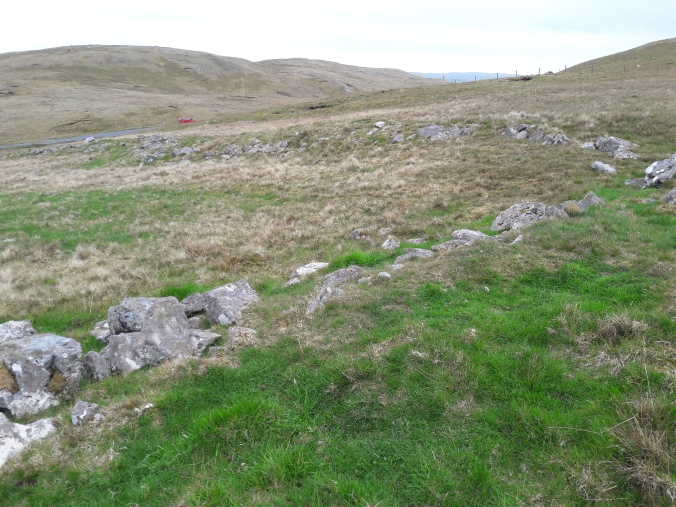
At Stanydale you can see more farm houses, and even the impressive walls of a much larger building, believed to be a temple or community hall. The hefty boulders which make up the building were believed to have been brought from far away, unlike the smaller rocks used for the farmsteads. Arguable the most significant, and impressive site in Shetland is Jarlshof, where several layers of history have been exposed at once due to a storm in the 19th century. Here we see a Neolithic farmstead, a bronze age forge, an iron age broch, a wheel house from 200BC, a Viking long house, a medieval farmhouse and finally a lairds mansion, all amazingly preserved. The beauty of the site is the ability to wander through the ruins, looking at piles of seashell fragments left from meals eaten over 2,000 years ago, pass by grain grinding stones, well worn by hard days of toil, and step through diminutive archways into an ancient family home, its chambers laid out like the spokes of a wheel.
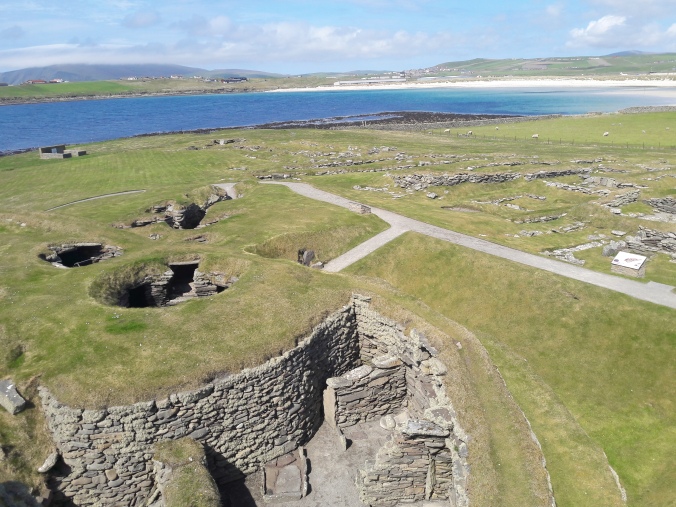
Another significant historical landmark is the world famous broch of Mousa (broch pronounced like loch – despite knowing this I repeatedly talk of the amazing broach we recently went to see). Over 700 broch remains are known of throughout the north of the Scotland and its islands, and many of them are easy to pay a visit to. Yet almost all are now simple circles of crumbled rocks, hard to gain inspiration from. The broch on Mousa is significant because it still stands. A combination of thicker, taller walls (making it stronger and more stable than some other brochs), and the good luck that no local farmers decided to repurpose the stones into a drystone wall or a barn extension, as has so often happened. There are few 2,000 year old structures which you can not only walk through but climb up the uneven, tiny steps of. Standing on, what for no better word, I’ll call the battlements you can look out on a view which probably hasn’t altered significantly since great the broch was first constructed. Once a look out point, sign of power, fortress and communal living space, now a monument to an age long passed.
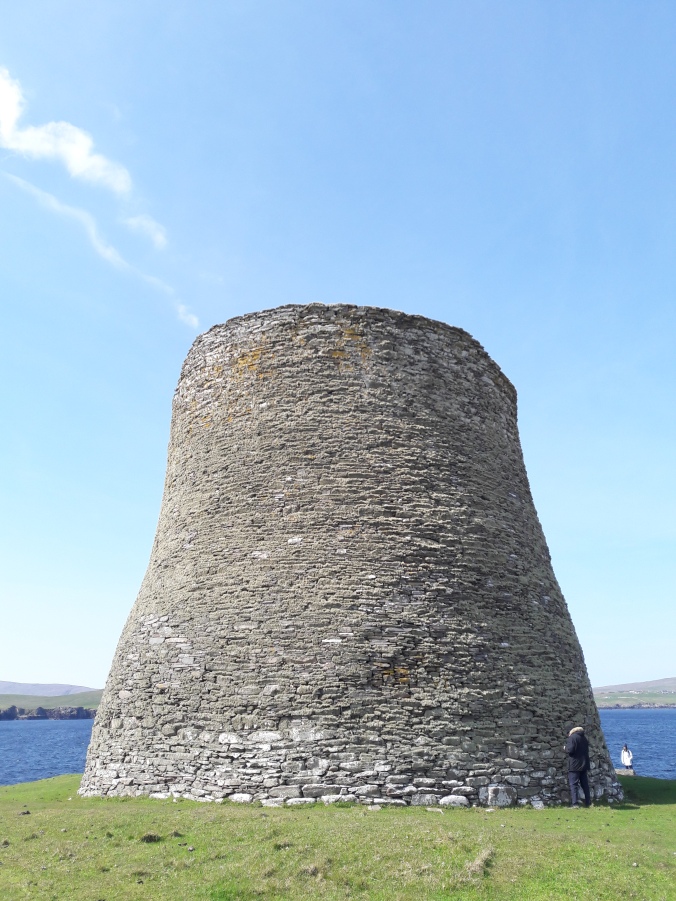
As with many places in the British isles Shetland’s farming practices, and a wetter climate, eventually led to the expansion of the blanket bogs. The layers of peat, which swamped large areas of fertile land causing abandonment of areas farmed in some cases for thousands of years, has helped preserve much of what was left behind, swaddling it like a blankets and keeping off the harshest forces of erosion.
Much is still unknown about the time before the Vikings, who arrived some 800 years ago. From Pictish carvings and Christian remains it is clear both the Picts and the Christian theology had reached Shetland before the Vikings laid claim to it. However once the Vikings had arrived they settled, farming the land like those before them, leaving their own ruins and culture behind, from festivals still celebrated today (like the mid-winter Up-Helly-Aa) to the many Viking place names, and a strong genetic link within the current Shetland people.

Finally Shetland, along with one of the other Viking strongholds Orkney, was lost to the dynasty, due to the Danish royalty’s lack of cash, traded in place of a dowry with the Scottish monarch James III on his marriage to a Danish princess. Today Shetland still retains its mix of Scandinavia and Scotland, with many brightly coloured Norwegian houses settled amongst the rolling heather hills.
After the Vikings, Shetland saw a tumultuous few centuries. Like much of the uplands it suffered from the highland clearances, with lairds removing tenants from the land in favour of sheep. This bitter episode in history was carried out for complex reasons, and with different lairds acting with varying degrees of kindness and cruelty. Its origins were in some cases down to the debts of the landowners, who needed greater productivity from the land. Other landowners were immensely wealthy and simply seized the chance at more wealth. A secondary aspect was the unsustainable population growth in these areas, causing regular famines amongst the subsistence farmers. In all, the movement of the people from the moorlands to lowland areas, or newly created coastal villages, was to enable the Scottish agricultural revolution, changing the way the land was managed to make a greater profit from it. Relocated tenants were expected to start a new life crafting, fishing or farming seaweed. In some cases the movement was coordinated with the will of the people but the majority of the movements were against the wishes of the displaced tenants and many fought back or left the areas entirely. Today the empty ruins, many still standing, their roofs long gone, burnt out to prevent the people from returning, are still a visible reminder of a land which once belonged to many being taken over by a few, a pattern which has repeated itself again and again thought our global history.

Today Shetland is thriving, with the main industries being oil, fishing, agriculture, tourism and knitwear. The Shetland pony, once used to carry peat across the moors, and bred smaller still to send into coal mines on the mainland, has become somewhat of an icon, its modern popularity meaning there are around 100 Shetland pony breeders on the island. Other Shetland breeds include the Shetland sheep, which comes in a veritable feast of colours, from black to caramel to spotted, and the domesticated Shetland goose, which unusually has a white female and a male with grey patches. Unfortunately much of Shetland is now occupied with more commercial breeds such as the intensely ugly but robust texel sheep. And whilst some farmers do still practice the traditional methods of managing the land, certainly far more than on the mainland, much is now farmed with modern, less nature friendly methods.
Wildlife
Birds are the highlight of Shetland’s wildlife. Here we get many of the species for which the rest of the UK is often too mild a climate, as well as a number of exotic migrants on their way to and from their breeding grounds. On our time in Shetland some of the more exciting species to turn up included a couple of bluethroats, a wryneck and a bee eater. Of course being in the right place at the right time for these birds is part luck and part pure twitcher determination. We didn’t spot any of the truly unusual species on our visit but had several migrants to admire.

The coastal birds of Shetland are impressive both because they can only be seen in a few key spots across the UK, largely islands and coastal cliffs, and because they come in great numbers. Gannets, guillemots, black guillemots, fulmar, terns and puffins, chatter and squawk and stink as they throng so closely together you could go mad trying to count them (a task best left to the experts). In bays and lochs eiders, long tailed ducks, red-throated divers, great northern divers and widgeon float back and forth, whilst on the beach redshank, turnstones, oystercatchers, knot, dunlin and sanderling run up and down the surf or poke their beaks amongst the silt.

Otters are of course the winner of the most desirable land mammal to spot on the islands, and luckily they are in high numbers across the coasts, with food plentiful in the sea, and rivers and lochs close by to wash the salt from their fur. Everywhere we found large sea urchins which had been prised apart and eaten, the most likely culprit being the nibble handed otter.
Sea mammals are less easy to spot, aside from the ubiquitous common and grey seals, which lounge like giant grey bananas on the rocks, or pop their heads above the water to watch you go by with large curious eyes. Orcas, sperm whales, humpback whales, white beaked dolphins and harbour porpoises all use the waters around Shetland, some simply passing by whilst others are long-term visitors. Seeing them is however down to luck, as it usually is with wildlife.

Aside from the mammals Shetland has an interesting variety of insects and wild flowers, including wonderful orchids like the early purple and frog orchids, and insects such as the fantastically colourful moss carder bumblebee. In the summer many of the fields, still managed in more wildlife friendly traditional methods, are festooned with wild flowers, with the butterflies and bees following.

The aquatic life in Shetland is wonderfully diverse but somewhat harder to spot than the life above the waterline. Glimpses can be snatched here and there. We watched sand eels swimming in the shallows at Mousa, and found scarlet bead anemones amongst rock pools. My favourite spot however was a sea cockroach, a type of isopod which looks rather like a giant wood louse, scuttling amongst the damp rocks on craggy sea cliff.
Environment
Shetland is a haven for wildlife, there is no doubt about that. This is largely down to its positioning and geology, being the perfect stopping off point for migrating, or lost, birds, and an excellent breeding spot for seabirds. Yet that doesn’t mean it is immune to environmental degradation. Like much of the UK vast areas are currently overgrazed, over drained and inappropriately burnt. I do not say this to blame the farmers and crofters who manage much of the land, much of Shetland is marginal farm land meaning pushing it hard has been the only way to make it productive. However in this day and age we need to weight up the cost of producing food with the quantity we produce and work out where the benefits to wildlife might be greater than what we can realistically and sustainably grow. Of course this should not mean removing farming entirely from the island or leaving the Shetlanders without income, but we may be able to find a compromise by paying for the ecosystem services where we could gain more from healthy peatlands than sheep meat and wool.

Another environmental problem obvious on Shetland is peat cutting. Peat cutting is carried out to provide a source of fuel for home fires, with a long ridge being cut in the peat and blocks of the dark brown matter being removed and stacked to dry. The same face is then often cut again and again in years that follow. Old and new peat cutting scars can been seen across much of Shetland. The issue with these cuts is the nature of peat, which holds water like a sponge. Once cut into that water drains out and the top most peat can dry and crack. Once this happens the rare and unusual peatland plants disappear and the peat begins to degrade, releasing the ancient carbon it has stored back into the atmosphere, adding to the greenhouse effect fuelling climate change.
Historically peat would have been the only feasible fuel for fires (once all the scrub has been cut down) however today wind would be one of the simplest ways to power Shetland’s hamlets and heat houses. Of course this is not something many of those cutting peat can afford to put in place themselves, and wood must be extravagantly expensive from the mainland, meaning change can only come from external funding. Yet looking at the scarred landscape, with so much of the peatland degraded by this practice I can’t help feel that this would be worth the investment, particularly as with the right restoration work the peatland could soon heal and beginning burying carbon once more.
Having mentioned scrub I will have to mention a controversial opinion. Shetland needs more scrub. Often we are short-sighted in our opinion of how the landscape should look, thinking what we’ve lived with for the last few hundred years is just how it should be. Yet Shetland historically would have been covered in scrub, long ago cleared for firewood and land improvement. Today scrub is largely confined to a few blocks of (largely non-native) plantation woodland, and the decorative scrub surrounding the Shetlander’s gardens. So little exists that birders gravitated to any they see, knowing it will probably contain a lost and rare woodland bird. Our one visit to an area of scrub (a small planted patch next to a garden) quickly produced a spotted flycatcher and a sparrowhawk. Yet today many moorland and grassland birds thrive on Shetland, therefore re-scrubbing the whole island would be unwise (and severely annoy the diligent farmers), but more scrub would provide an additional habitat to the island and give some of the most degraded land a rest from the hungry mouths of sheep. The Shetland Amenity Trust (who seem to do a great deal of excellent conservation and education work in Shetland) are themselves planting new areas of scrub across Shetland, so change is already coming, however these current small patches could benefit from being significantly expanded.

Plastic pollution is a problem everywhere, however Shetland, with its 900 miles of coastline and its large number of seabirds, does bring the problem to light in more obvious ways. On Noss we saw tangles of blue ropes and fishing lines in the nests of almost all the gannets. These plastic threads can wrap around birds and chicks, trapping them till they starve. On Norwick beach we found a dead gannet, pieces of plastic still in its bill, and probably a belly full of it too. And just down the beach another unhappy gannet sat, clearly ill. Though we couldn’t be sure of the cause undigested plastic is a more common death now for these birds than ever. On every beach we visited we found plastic rubbish, from water bottles to whole fishing nets to bits of sillage wrap blown from farms. The majority seemed to stem from the fishing industry and farms. Whilst we all have a part to play in plastic pollution, by reducing our waste, disposing of it properly and picking up a little litter every place we visit, there are big changes needed within industries which can’t be altered by individuals. Just like wind farms replacing peat cutting the change of plastic base nets to something biodegradable is going to need financial help, from research work to assisting businesses in changing over. Because the fact is that nets and lines will always be lost at some point and by some accident, and at the moment they live forever, littering our beaches and polluting our sea life, whereas they need to be able to degrade naturally with fewer long term consequences. There is also need to invest in changes to regularly used farm plastic, particularly in coastal areas. Whilst sillage wrap, sheep lick buckets and bailer twin is an issue everywhere, the route to disaster is so much quicker when the pasture ends in a sea cliff.
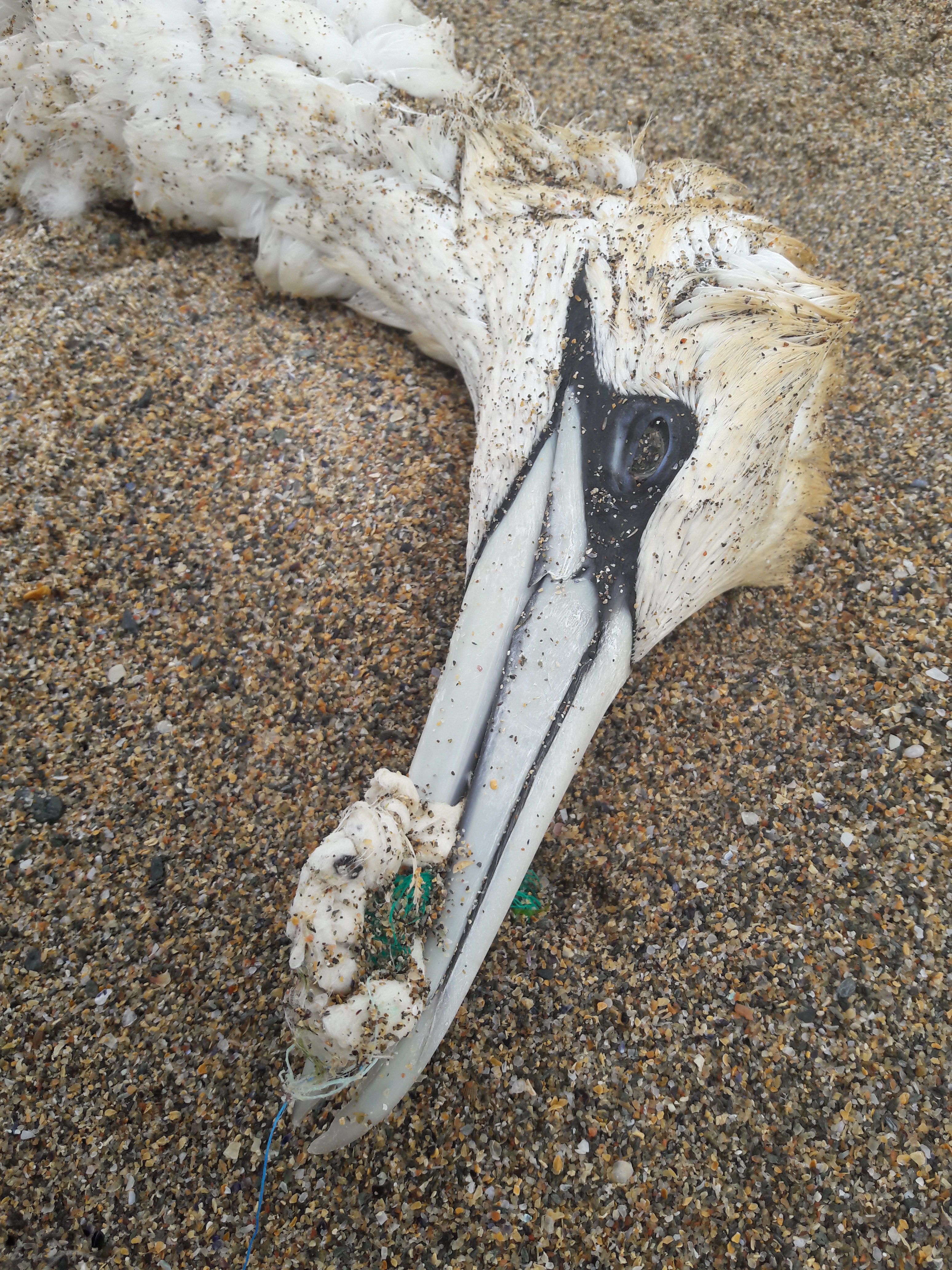
Travel
Reaching Shetland can feel like an epic undertaking, more akin to travelling to some far off exotic continent than heading to the other end of the British isles. Flights to the main airport at Sumburgh are inordinately expensive considering you don’t leave the country, and rather irregular, but do now go from Manchester and well as London airports. An alternative is the ferries which run from Aberdeen to Shetland’s capital in Lerwick. Taking around 15hrs the ferry may seem like an archaicly slow mode of transport, however it has three major advantages over flying. Firstly its carbon footprint is a fraction of that of flying, secondly it travels overnight, meaning the majority of the journey takes place whilst you sleep, and thirdly wildlife watching can be spectacular, with killer whales, gannets, puffins, and even occasionally storm petrels enjoying the ferries slipstream.

Once on the islands there is the choice of public transport with buses being relatively regular to many of the main attractions in the mainland, however once you get off the tourist drag the services can be only a few times a day, meaning missing your bus could lead to a long wait. Taxi companies do operate, though our one experience of them found them rather pricey. Many offer a tour service, taking you round the main sites for a day price. Car hire (or bringing your own car via the ferry) is by far the simplest way to travel, with the roads being quiet and well signed, though mostly single tracked (with regular passing places) and scattered with startled sheep. Several car hire businesses also offer bike hire. Biking around Shetland is very enjoyable but, though relatively flat and compact compared to mainland Scotland, the hills are bigger than they seem and the distances further.
Between the islands the small car ferries, which you can also use as a foot or bike passenger, are superb, offering a regular, cheap service.
Summary
Shetland is, and always will be, somewhat removed from the rest of the British Isles. Far out to sea it has its own culture, landscape and problems. If nothing else it is a wonderful place to visit to remind ourselves of the diversity of our country and then different ways of living and thriving within it. And of course there’s the puffins, northern lights and Viking heritage to enjoy. Yes it’s a long way away, and short on shopping centres, clubs and coffee shops, but perhaps that is in fact one of its greatest attractions rather than it’s downfall.
